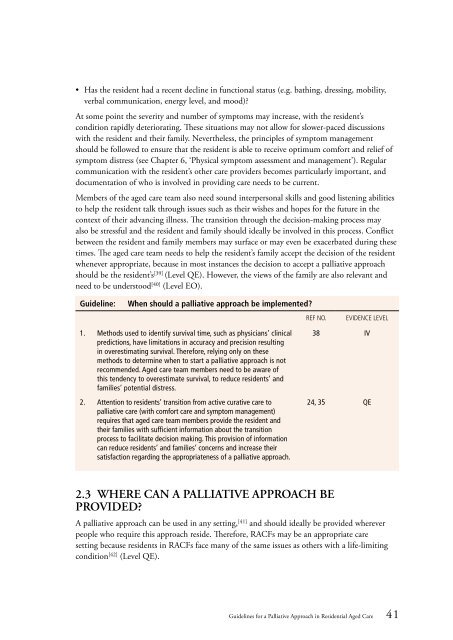Guidelines for a Palliative Approach in Residential Aged Care
Guidelines for a Palliative Approach in Residential Aged Care
Guidelines for a Palliative Approach in Residential Aged Care
You also want an ePaper? Increase the reach of your titles
YUMPU automatically turns print PDFs into web optimized ePapers that Google loves.
• Has the resident had a recent decl<strong>in</strong>e <strong>in</strong> functional status (e.g. bath<strong>in</strong>g, dress<strong>in</strong>g, mobility,<br />
verbal communication, energy level, and mood)?<br />
At some po<strong>in</strong>t the severity and number of symptoms may <strong>in</strong>crease, with the resident’s<br />
condition rapidly deteriorat<strong>in</strong>g. These situations may not allow <strong>for</strong> slower-paced discussions<br />
with the resident and their family. Nevertheless, the pr<strong>in</strong>ciples of symptom management<br />
should be followed to ensure that the resident is able to receive optimum com<strong>for</strong>t and relief of<br />
symptom distress (see Chapter 6, ‘Physical symptom assessment and management’). Regular<br />
communication with the resident’s other care providers becomes particularly important, and<br />
documentation of who is <strong>in</strong>volved <strong>in</strong> provid<strong>in</strong>g care needs to be current.<br />
Members of the aged care team also need sound <strong>in</strong>terpersonal skills and good listen<strong>in</strong>g abilities<br />
to help the resident talk through issues such as their wishes and hopes <strong>for</strong> the future <strong>in</strong> the<br />
context of their advanc<strong>in</strong>g illness. The transition through the decision-mak<strong>in</strong>g process may<br />
also be stressful and the resident and family should ideally be <strong>in</strong>volved <strong>in</strong> this process. Conflict<br />
between the resident and family members may surface or may even be exacerbated dur<strong>in</strong>g these<br />
times. The aged care team needs to help the resident’s family accept the decision of the resident<br />
whenever appropriate, because <strong>in</strong> most <strong>in</strong>stances the decision to accept a palliative approach<br />
should be the resident’s [39] (Level QE). However, the views of the family are also relevant and<br />
need to be understood [40] (Level EO).<br />
Guidel<strong>in</strong>e:<br />
When should a palliative approach be implemented?<br />
Ref No.<br />
Evidence level<br />
1. Methods used to identify survival time, such as physicians’ cl<strong>in</strong>ical<br />
predictions, have limitations <strong>in</strong> accuracy and precision result<strong>in</strong>g<br />
<strong>in</strong> overestimat<strong>in</strong>g survival. There<strong>for</strong>e, rely<strong>in</strong>g only on these<br />
methods to determ<strong>in</strong>e when to start a palliative approach is not<br />
recommended. <strong>Aged</strong> care team members need to be aware of<br />
this tendency to overestimate survival, to reduce residents’ and<br />
families’ potential distress.<br />
2. Attention to residents’ transition from active curative care to<br />
palliative care (with com<strong>for</strong>t care and symptom management)<br />
requires that aged care team members provide the resident and<br />
their families with sufficient <strong>in</strong><strong>for</strong>mation about the transition<br />
process to facilitate decision mak<strong>in</strong>g. This provision of <strong>in</strong><strong>for</strong>mation<br />
can reduce residents’ and families’ concerns and <strong>in</strong>crease their<br />
satisfaction regard<strong>in</strong>g the appropriateness of a palliative approach.<br />
38 IV<br />
24, 35 QE<br />
2.3 WHERE CAN A PALLIATIVE APPROACH BE<br />
PROVIDED?<br />
A palliative approach can be used <strong>in</strong> any sett<strong>in</strong>g, [41] and should ideally be provided wherever<br />
people who require this approach reside. There<strong>for</strong>e, RACFs may be an appropriate care<br />
sett<strong>in</strong>g because residents <strong>in</strong> RACFs face many of the same issues as others with a life-limit<strong>in</strong>g<br />
condition [42] (Level QE).<br />
<strong>Guidel<strong>in</strong>es</strong> <strong>for</strong> a <strong>Palliative</strong> <strong>Approach</strong> <strong>in</strong> <strong>Residential</strong> <strong>Aged</strong> <strong>Care</strong> 41
















